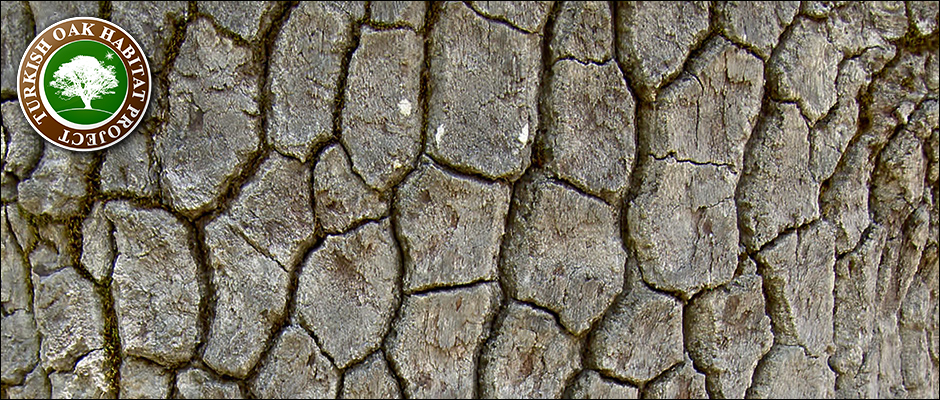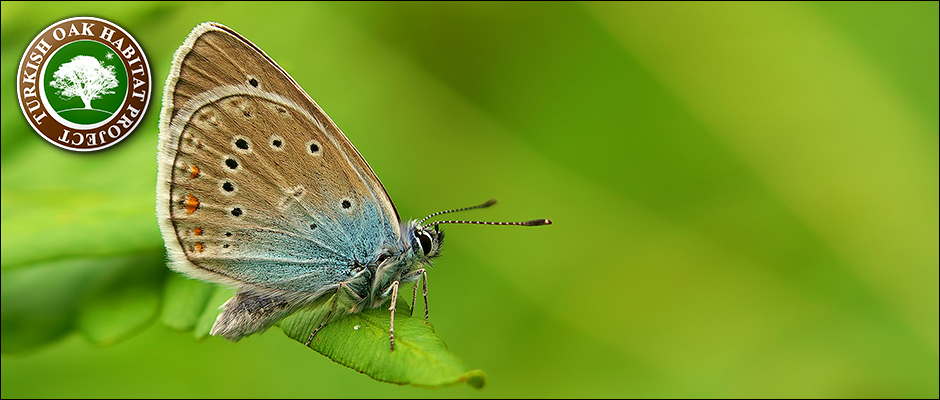Turkish oak species…
Quercus coccifera (Kermes oak)

This species is called Kermes oak in english and “Kermes meşesi” in Turkish language and means cochineal oak. It originate from a bug living on Kermes oak used for producing red colors. It’s one of the most wide spread oaks species in Turkey from North west along the Mediterranean coast all the way to Gazientep in the south east part of the country but also in some regions in the Black sea coast like Giresun. It is seldom found higher that 1000m above sea level. Q. coccifera seldom grove large as a tree its often hiding together with thorny bushes in the maquis vegetation in warm and dry mountain slopes. The reason why it is not so often seen as a tree is human treatment by cutting and browsing from cheeps and goats and is often found looking as bonsai. But if the plant is protected from these activities it can grove to a large tree more than 15 meter high and with a steam diameter of more than 50cm at breast hight. The wood is very hard and almost impossible to penetrate with a nail. The leaves are small (2-5cm x 1-2cm), shiny, hard and have most often thorny borders. They are without pubescens, dark green but have a redish coloration when young. The tree is ever green. When the acorns are mature they are green and shiny without pubescens, have a slender shape, around 3cm long and 1,5cm wide. The cup is green beige and has a surface with small pointing thorns.

Quercus aucheri

In Turkish language it is called “Boz pırnal meşe” wish means gray holm oak. It is one of the endemic oak species to Turkey and can only be found in the south west part of the country from Antalya along the coast up to Aydin. It groves from sea level and is seldom found above 400m above sea level. It is often found in dry rocky mountain slopes sometimes together with Quercus coccifera mixed with the maccia bushes. It is most often not more than 2 meter high, bush shaped like Q. coccifera, but can also grow to a 10 meter high tree with a steam breast hight diameter of 1meter if it is protected from browsing. The leaves are similar to Q. coccifera, but is darker green, with fine grey hairs, thorny borders (when young) and 2-4cm long and 1-2 cm wide. The tree is ever green. The acorns are grey green with a fine white pubescens. The shape is less slender than for Q. coccifera with a length of 2-2,5cm and a width of 1,5-2cm. The cup has a grained surface and is grey green. It takes 2 years for acorn for become mature. The wood of Q. aucheri is very hard.

Quercus ithaburensis (Mount Thabor’s oak)

This species is called “Anadolu palamut meşesi” in Turkish language with the meaning Anatolian acorn oak. The name origin from the large acorn. Q.ithaburensis is spread in the southern part of the country from sea level up to 1500m. This species can grove to a large tree over 20m high, with a steam diameter of more than 1 meter and a wide crown. The leaves are dark green with a dense white pubescens giving the tree a grey green color in distance. The leaves are thick, egg shaped, 5-10cm long and with pointing lobes. The acorns are very big and can be up to 5cm long and 3 cm wide. They are green with a fine white pubescens on the top. The cup of the acorn has very long hair like cupscales. The tree has often been used by humans as a recourse taking the leaves as animal fodder and the twigs and branches cut for heating houses and for cooking.

Quercus ilex (Holm oak)

The name in Turkish language is “Pırnal meşe” wish means holm oak. Quercus ilex is not so spread in Turkey. You find it most often planted in villages and cities on the west Mediterranean coast from Mugla in south to Canakkale and from Istanbul to Samsun on the black sea coast. Q. ilex can be 20m high and a steam diameter of 2m in good conditions. The leaves are small (5-8cm), dark green, but grey under side, egg shaped and most often with spiny borders. The tree is ever green and keep each leave for 3-6 year. The acorn is light green, small (1,5-2cm x 1cm), with a pointing top and the cup is grey with a smooth surface. In distance the bark on the trunk often looks dark grey or dark brown and not so deep bark fissures are not so deap.

Quercus infectoria (Aleppo oak)

The name in Turkish language is “Mazı meşesi” wish means the oak with galls and Quercus infectoria often has galls from the gall wasp Cynips quercusfolii. Quercus infectoria is spread over the most part of Turkey and can be found up to 1500m. The tree is often small but in good condition can it be 15m high and more than 2 meter in trunk diameter. The leaves can variate but are grey-green, without pubescens and often small (6×3 cm) with rounded teeth around its border. The acorn are small and slender the cup with a smooth surface. The acorns has been used as human food in some parts of Turkey. The bark is often light grey and with shallow bark cracks.


Quercus cerris (Turkish oak)

In Turkish this oak is called “Saçlı meşe” wish means the haired oak. Quercus cerris can be found in most parts of Turkey up to 1000m altitude. The tree can in good condition be 35m high and the trunk nearly 3 m in diameter. The bark of older trees is dark grey and deeply furrowed. The leaves are 7-14 cm long and 3-5 cm wide, with 6-12 triangular lobes on each side the regularity of the lobes are often less regular than other species. The depths of the lobes variate. Often the leaves has a grey pubescens. The acorn is 3-4 cm long and 2 cm broad the cup is 2 cm deep, densely covered in soft 4-8 mm long ‘mossy’ bristles.

Quercus libani (Lebanon oak)

In Turkish this oak is called “Lübnan meşesi” wish means Lebanon oak. Quercus libani is distributed in the south east part of Turkey and in higher altitudes up to 2000m. The tree can be 15m high and the trunk 1 m in diameter. The bark of older trees are less deeply furrowed than most other oaks. The leaves are slender and 7–12 cm long and 2-3 cm wide, with numerous small pointing teeth on each side the leaf. Often the leaves have a shiny surface with less hairs. The acorn is 3-4 cm long and 2-3 cm broad the cup is 2 cm deep covering 2/3 of the acorn, densely covered with fish-skin like bristles.
Quercus trojana (Makedonian oak)

In Turkish this oak is called “Makedonya meşesi”. Quercus trojana is distributed in the western part of Turkey and in higher altitudes up to 2000m. The tree can be 15m high and the trunk 1 m in diameter. The bark of older trees are less deeply furrowed than most other oaks. The leaves are slender and 5-10 cm long and 2-3 cm wide, with numerous (but less than libani) small pointing teeth on each side the leaf. Often the leaves have a shiny surface with less hairs. The acorn is 3-4 cm long and 2-3 cm broad the cup is 2 cm deep covering 2/3 of the acorn, densely covered with fish-skin like bristles.

Quercus brantii (Persian oak)

In Turkish this oak is called Kara meşe. This name means black oak. Quercus brantii distribution is restricted to the south east quarter of Turkey. It grows different altitudes from 400 level up to 1700m. The tree can be 15m high and the trunk 0,5m in diameter in good conditions. The bark of older trees are medium shallow furrowed. The leaves are egg shaped and 4-7cm long and 3-5cm wide. They are thick, green-grey with a dens pubescens and with small pointing teeth on each side the leaf. Quercus brantii has acorns sitting directly on the twigs. The acorn is very big and can be 4-5 cm long and 3 cm broad. The cup covering 1/2 of the acorn and have long hair-like bristles. The acorn is still used as food for humans and fodder to animals in some regions of Turkey.
Quercus vulcanica (Kasnak oak)

In Turkish this oak is called “Kasnak meşesi”. Quercus vulcanica is an endemic species and has a restricted distribution in a part of Taurus mountains in Turkey. It grows only in higher altitude from 1300 to 1800m. The tree can be 30m high and the trunk 1,5m in diameter in good conditions. The bark of older trees are more shallow furrowed than most other oaks. The leaves are 10-16cm long, 8-12cm wide. They are similar to leaves of Q. frainetto with deep lobes. The leaves are also less shiny and have small hairs. Quercus vulcanica has acorns sitting directly on the twigs. The acorn is 2-2,5 cm long and 2 cm broad and the cup covering 1/3 of the acorn and have fish-skin like bristles.

Quercus robur (Pedunculate oak)

In Turkish this oak is called “Saplı meşe”. Quercus robur has a scattered distribution in Turkey. It can be found around Marmara sea, along Black sea coast, in the central parts down to the most south east corner of Turkey. It grows in many different altitudes from 100m up to 2000m. The tree can be 40m high and the trunk 3m in diameter in good conditions. The bark of older trees are more deeply furrowed than most other oaks. The leaves are often 8-12cm long, 5-8cm wide and have a few deep rounded lobes on each side and have a short stalk (petiole). The leaves have a shiny surface without any hairs. Quercus robur has pedunculate (stalked) acorns with 2-3 acorns per stalk. The acorn is 2-3 cm long and 1,5-2 cm broad the cup covering 1/3 of the acorn.

Quercus frainetto (Hungarian oak)

In Turkish this oak is called “Macar meşesi”. This name means hungrian oak. Quercus frainetto is widespread in Turkey. It have a restricted distribution and can only be found in northwest part of Turkey. It grows in many different altitudes from sea level up to 1000m. The tree can be 30m high and the trunk 2m in diameter in good conditions. The bark of older trees are shallow furrowed. The leaves are 10-18cm long, 8-12cm wide. They are similar to leaves of Q. petraea but is often larger have a deeper and less rounded lobes. The leaves are also less shiny and have small hairs. Quercus frainetto has acorns sitting directly on the twigs. The acorn is 2-3 cm long and 1,5-2 cm broad and the cup covering 1/3 of the acorn and have fish-skin like bristles.

Quercus petraea (Sessile oak)

In Turkish this oak is called “Sapsız meşe”. This name means that the acorns are sessile or stalkless. Quercus petraea is widespread in Turkey. It can be found in all parts except the south west quarter of Turkey. It grows in many different altitudes from sea level up to 1500m. The tree can be 30m high and the trunk 2m in diameter in good conditions. The bark of older trees are more shalow furrowed than most other oaks. The leaves are 6-12cm long, 3-6cm wide. They are similar to leaves of Q. robur but have a higher number and less rounded lobes on each side and have a longer stalk. The leaves have a shiny surface without any hairs. Quercus petraea has acorns sitting directly on the twigs. The acorn is 2-3 cm long and 1,5-2 cm broad the cup covering ¼-1/3 of the acorn.












